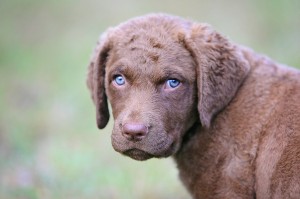So you brought home your Chessie puppy and you noticed that he/she constantly bites at you. The pup might grab your arms, your feet and pant legs. And, sometimes,  the puppy might go berserk just wanting to bite, bite, bite all the time.
the puppy might go berserk just wanting to bite, bite, bite all the time.
This biting doesn’t mean you have an aggressive pup, so don’t lose faith just yet. With time and proper training, it can and will subside.
Human babies explore things with their hands. They are constantly grabbing, touching and reaching. Retriever babies explore everything with their mouths – hence they bite all the time. It’s now your job to teach the pup what is, and what isn’t, appropriate to bite. Remember that the biting is very normal behavior for a Chessie puppy.
Teaching the “NO BITE” command is rather easy. However, it takes diligence and time before it works effectively. Every person in the house should use this method so there’s consistency in training. The more consistent and diligent the training is, the quicker you’ll get the results you desire.
When a puppy goes to bite, grab the lower jaw firmly in your hand by placing your thumb under the tongue and wrapping your index finger under the chin. Then, lightly push the jaw down and hold for 3-5 seconds. While you do this, tell the pup in a firm voice “NO BITE” and then give him something acceptable to chew on such as a bone or toy. If the puppy tries to bite you again, then hold the jaw firmly open, again, only this time do it a little longer and re-issue the “NO BITE” command in a firm voice. Again, after you issue the command, give the pup an acceptable chew toy.
The lower jaw of a dog is hinged. When you hold its jaw firmly open, as outlined above, the puppy has no control over its mouth. As such, most puppies HATE this correction and they might struggle when you hold their jaw open. Although it takes time (and persistence) the puppy will start learning the “NO BITE” command and will stop biting when you issue it.
It’s important to teach your puppy the “NO BITE” command. By not doing so, and allowing the unwanted behavior to continue, a very bad habit can develop that often leads to nipping and even biting in older dogs.
